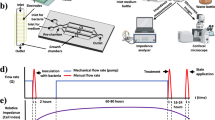Abstract
Methicillin Resistant Staphylococcus pseudintermedius (MRSP) biofilm-related infections are currently a leading concern for veterinary hospitals, as these types of infections are highly resistant to assaults by both the immune system and antimicrobial therapies, impeding their clearance. Research suggests that fosfomycin, a low molecular weight bactericidal antibiotic, has the potential to effectively penetrate and subsequently disrupt/destroy biofilm layers. Our study utilized a fabricated microfluidic gradient generator platform as an assay to perform a quantitative assessment of varying concentrations of a selected antimicrobial agent against MRSP biofilm formed under physiologically relevant conditions. Our results verified the feasibility of using a microfluidic device for rapid antimicrobial testing against biofilms, which was successful in demonstrating that fosfomycin is an effective agent that can disrupt established MRSP biofilms. Additionally, Atomic Force Microscopy (AFM) analysis revealed that the cell walls of MRSP cells within the biofilms were disrupted by fosfomycin treatment, which speaks to the mechanism of action and the antimicrobial efficacy of this agent. This study provides compelling evident that microfluidic device and nanoscale AFM imaging-based investigations of biofilms can aid in the study of biofilm-related infectious diseases.
Similar content being viewed by others
References
Weese, J.S. A review of multidrug resistant surgical site infections. Vet. Comp. Orthop. Traumatol. 21, 1– (2008).
Vasseur, P.B., Levy, J., Dowd, E. & Eliot, J. Surgical wound infection rates in dogs and cats data from a teaching hospital. Vet. Surg. 17, 60–4 (1988).
Nicholson, M., Beal, M., Shofer, F. & Brown, D.C. Epidemiologic evaluation of postoperative wound infection in clean-contaminated wounds: A retrospective study of 239 dogs and cats. Vet. Surg. 31, 577–81 (2002).
Eugster, S., Schawalder, P., Gaschen, F. & Boerlin, P. A prospective study of postoperative surgical site infections in dogs and cats. Vet. Surg. 33, 542–50 (2004).
Parra-Ruiz, J., Vidaillac, C., Rose, W.E. & Rybak, M.J. Activities of high-dose daptomycin, vancomycin, and moxifloxacin alone or in combination with clarithromycin or rifampin in a novel in vitro model of Staphylococcus aureus biofilm. Antimicrob. Agents Chemother. 54, 4329–334 (2010).
Klapper, I., Rupp, C.J., Cargo, R., Purvedorj, B. & Stoodley, P. Viscoelastic fluid description of bacterial biofilm material properties. Biotechnol. Bioeng. 80, 289–96 (2002).
Fujimura, S. et al. Combined efficacy of clarithromycin plus cefazolin or vancomycin against Staphylococcus aureus biofilms formed on titanium medical devices. Int. J. Antimicrob. Agents 32, 481–84 (2008).
Gortel, K. et al. Methicillin resistance among staphylococci isolated from dogs. Am. J. Vet. Res. 60, 1526–530 (1999).
Vengust, M., Anderson, M.E., Rousseau, J. & Weese, J.S. Methicillin-resistant staphylococcal colonization in clinically normal dogs and horses in the community. Lett. Appl. Microbiol. 43, 602–06 (2006).
Weese, J.S. A review of post-operative infections in veterinary orthopaedic surgery. Vet. Comp. Orthop. Traumatol. 21, 99–05 (2008).
Chrobak, D. et al. Molecular characterization of Staphylococcus pseudintermedius strains isolated from clinical samples of animal origin. Folia Microbiol. (Praha) 56, 415–22 (2011).
Mikuniya, T. et al. Treatment of Pseudomonas aeruginosa biofilms with a combination of fluoroquinolones and fosfomycin in a rat urinary tract infection model. J. Infect. Chemother. 13, 285–90 (2007).
Kusachi, S., Nagao, J., Yoshihisa, S. & Watanabe, M. Antibiotic time-lag combination therapy with fosfomycin for postoperative intra-abdominal abcesses. J. Infect. Chemother. 17, 91–6 (2011).
Kumon, H., Ono, N., Iida, M. & Nickel, J.C. Combination effect of fosfoymcin and ofloxacin against Pseudomonas aeruginosa growing in a biofilm. Antimicrob. Agents Chemother. 39, 1038–044 (1995).
Kumar, A. et al. Microscale confinement features can affect biofilm formation. Microfluid Nanofluidi. 14, 895–02 (2013).
Dicicco, M., Neethirajan, S., Weese, J.S. & Singh, A. In vitro synergism of fosfomycin and clarithromycin antimicrobials against methicillin-resistant. Staphylococcus pseudintermedius. BMC Microbiol. 16473671 91113294 (2014).
Purevdorj, B., Costerton, J.W. & Stoodley, P. Influence of hydrodynamics and cell signaling on the structure and behavior of Pseudomonas aeruginosa biofilms. Appl. Environ. Microbiol. 68, 4457–464 (2002).
Weaver, W.M., Dharmaraja, S., Milisavljevic, V. & Di Carlo, D. The effects of shear stress on isolated receptor-ligand interactions of Staphylococcus epidermidis and human plasma fibrinogen using molecularly patterned microfluidics. Lab Chip 11, 883–89 (2011).
Lin, F. & Saadi, W. Generation of dynamic temporal and spatial concentration gradient using microfluidic devices. Lab Chip 4, 164–67 (2004).
Neethirajan, S. & DiCicco, M. Atomic force microscopy study of the antibacterial effect of fosfomycin on methicillin-resistant Staphylococcus pseudintermedius. App. Nanosci. doi:10.1007/s13204-013-0256-3 (2013).
Kim, S.P. et al. In situ monitoring of antibiotic susceptibility of bacterial biofilms in a microfluidic device. Lab Chip 10, 3296–299 (2010).
Osland, A.M., Vestby, L.K., Fanuelsen, H., Slettemeas, J.S. & Sunde, M. Clonal diversity and biofilm-forming ability of methicillin-resistant Staphylococcus pseudintermedius. J. Antimicrob. Chemother. 67, 841–48 (2012).
Jenks, P.S., Laurent, M., Mcquarry, S. & Watkins, R. Clinical and economic burden of surgical site infection (SSI) and predicted financial consequences of elimination of SSI from an English hospital. J. Hospital. Infection. 86, 24–3 (2014).
Stewart, P.S. Convection around biofilms. Biofouling: J. Bioadhe. Biofilm Res. 28, 187–98 (2012).
Toh, A.G.G., Wang, Z.P., Yang, C. & Nguyen, N. Engineering microfluidic concentration gradient generators for biological applications. Microfluid. Nanofluid. 16, 1018 (2014).
Selimovic, S. et al. Generating nonlinear concentration gradients in microfluidic devices for cell studies. Anal. Chem. 83, 2020–028 (2011).
Richter, L. et al. Monitoring cellular stress repsonses to nanoparticles using a lab-on-a-chip. Lab Chip. 11, 2551–560 (2011).
Nauman, E.A. et al. Novel quantitative biosystem for modeling physiological fluid shear stress on cells. Appl. Environ. Microbiol. 73, 699–05 (2007).
Beeson, J.G. et al. Adhesion of plasmodium falciparum- infected erythrocytes to hyaluronic acid in placental malaria. Nat. Med. 6, 86–0 (2000).
Ceri, H. et al. The Calgary Biofilm Device: new technology for rapid determination of antibiotic susceptibilities of bacterial biofilms. J. Clin. Microbiol. 37, 1771–776 (1999).
Author information
Authors and Affiliations
Corresponding author
Rights and permissions
About this article
Cite this article
DiCicco, M., Neethirajan, S. An in vitro microfluidic gradient generator platform for antimicrobial testing. BioChip J 8, 282–288 (2014). https://doi.org/10.1007/s13206-014-8406-6
Received:
Accepted:
Published:
Issue Date:
DOI: https://doi.org/10.1007/s13206-014-8406-6




